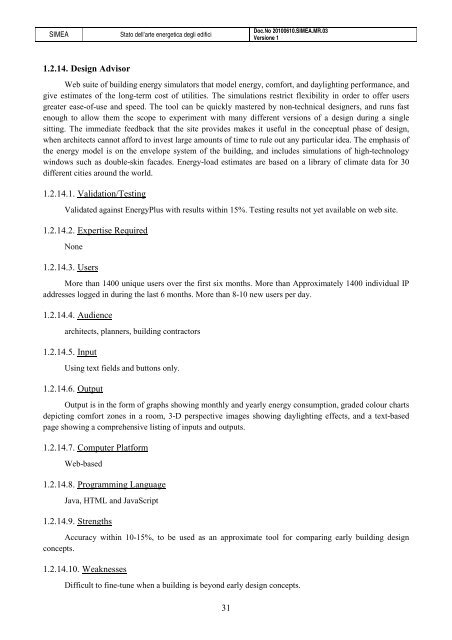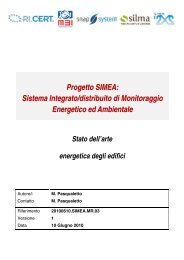Progetto SIMEA - Automatica - Università degli Studi di Padova
Progetto SIMEA - Automatica - Università degli Studi di Padova
Progetto SIMEA - Automatica - Università degli Studi di Padova
Create successful ePaper yourself
Turn your PDF publications into a flip-book with our unique Google optimized e-Paper software.
<strong>SIMEA</strong> Stato dell’arte energetica <strong>degli</strong> e<strong>di</strong>fici<br />
1.2.14. Design Advisor<br />
31<br />
Doc.No 20100610.<strong>SIMEA</strong>.MR.03<br />
Versione 1<br />
Web suite of buil<strong>di</strong>ng energy simulators that model energy, comfort, and daylighting performance, and<br />
give estimates of the long-term cost of utilities. The simulations restrict flexibility in order to offer users<br />
greater ease-of-use and speed. The tool can be quickly mastered by non-technical designers, and runs fast<br />
enough to allow them the scope to experiment with many <strong>di</strong>fferent versions of a design during a single<br />
sitting. The imme<strong>di</strong>ate feedback that the site provides makes it useful in the conceptual phase of design,<br />
when architects cannot afford to invest large amounts of time to rule out any particular idea. The emphasis of<br />
the energy model is on the envelope system of the buil<strong>di</strong>ng, and includes simulations of high-technology<br />
windows such as double-skin facades. Energy-load estimates are based on a library of climate data for 30<br />
<strong>di</strong>fferent cities around the world.<br />
1.2.14.1. Validation/Testing<br />
Validated against EnergyPlus with results within 15%. Testing results not yet available on web site.<br />
1.2.14.2. Expertise Required<br />
None<br />
1.2.14.3. Users<br />
More than 1400 unique users over the first six months. More than Approximately 1400 in<strong>di</strong>vidual IP<br />
addresses logged in during the last 6 months. More than 8-10 new users per day.<br />
1.2.14.4. Au<strong>di</strong>ence<br />
architects, planners, buil<strong>di</strong>ng contractors<br />
1.2.14.5. Input<br />
Using text fields and buttons only.<br />
1.2.14.6. Output<br />
Output is in the form of graphs showing monthly and yearly energy consumption, graded colour charts<br />
depicting comfort zones in a room, 3-D perspective images showing daylighting effects, and a text-based<br />
page showing a comprehensive listing of inputs and outputs.<br />
1.2.14.7. Computer Platform<br />
Web-based<br />
1.2.14.8. Programming Language<br />
Java, HTML and JavaScript<br />
1.2.14.9. Strengths<br />
Accuracy within 10-15%, to be used as an approximate tool for comparing early buil<strong>di</strong>ng design<br />
concepts.<br />
1.2.14.10. Weaknesses<br />
Difficult to fine-tune when a buil<strong>di</strong>ng is beyond early design concepts.
















